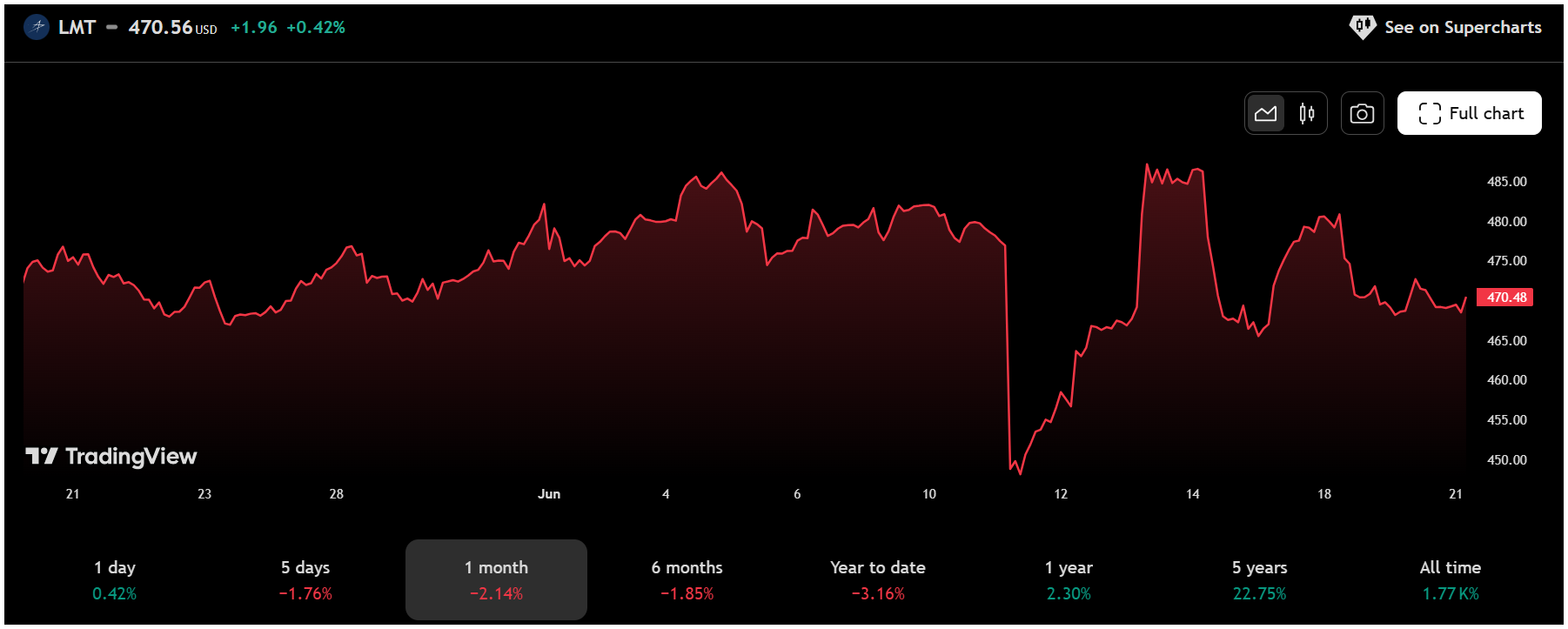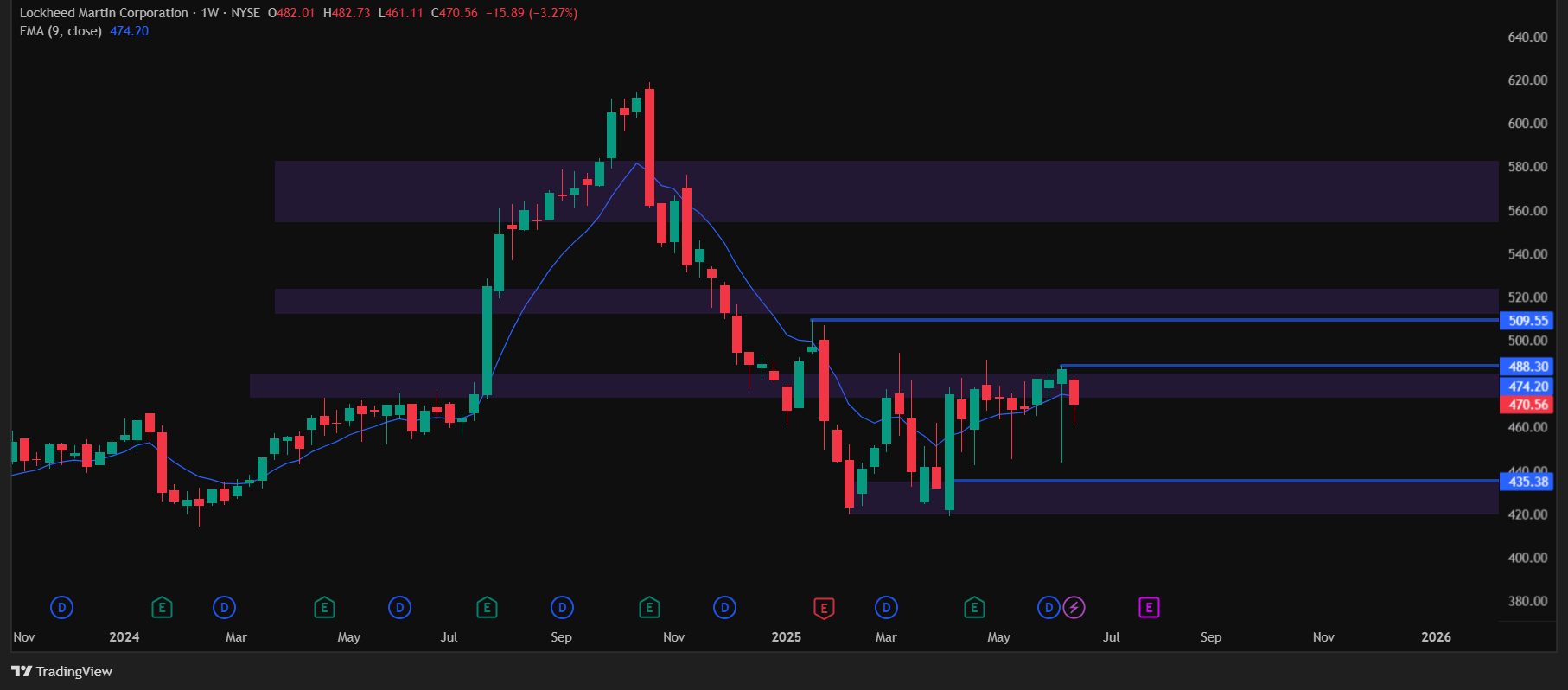Lockheed Martin Corporation (NYSE: LMT) rose slightly Friday, up 0.42 percent, but layoffs in its Aeronautics division and a 2.14 percent monthly decline have pushed its market cap to $110.25 billion. Investors are grappling with cost-cutting measures, F-35 challenges, and a strong global backlog, leaving questions about the stock’s future trajectory.
How Lockheed Martin Stock Performed in June?

LMT shares gained 0.42 percent Friday, closing at approximately $437.50. The stock has shed 2.14% this month, trading between $430 and $455, with volume near its June average. Over the past five days, shares fell 1.76 percent, while year-to-date losses stand at 3.16 percent. Longer-term, LMT is up 2.30 percent over one year and 22.75 percent over five years.
Latest News About Lockheed Martin Stock
Lockheed announced roughly 200 layoffs in its Aeronautics unit earlier in 2025, part of a 1 percent workforce reduction (about 1,140 jobs from 122,000 employees) to address F-35 program delays and supply chain pressures. Speculation suggests additional cuts at the Greenville, South Carolina facility, possibly tied to the non-renewal of an F-16 maintenance contract, though details are unconfirmed. The company is offering outplacement support and career counseling to affected workers.
Despite domestic hurdles, Lockheed’s 117-jet F-16 backlog for clients like Bahrain, Slovakia, and Taiwan, within a $173 billion total backlog, remains a cornerstone of its global business.
Friday’s 0.42 percent gain reflects cautious optimism that layoffs will shore up margins, despite a 2.14 percent monthly drop. The 2.81 percent dividend yield and robust international orders likely supported shares, though F-35 order reductions continue to weigh on sentiment.
Also Read – With 248% Return in June, CRCL Market Cap Hits $54 Billion – What Lies Ahead?
Technical Analysis and Price Target Forecast for Lockheed Martin Stock in June 2025

LMT is trading in a tight range, with support at $435 and resistance at $475. The 50-day moving average sits slightly above current levels, and an RSI of 48 signals neutral-to-bearish momentum. MACD indicates consolidation, reflecting investor uncertainty following layoffs.
If Lockheed Martin’s stock price manages to break above the recent resistance level near $475, we believe it could trigger bullish momentum. In that case, the stock has the potential to rally toward $509, which is seen as the next major upside target based on historical chart patterns and previous consolidation zones.
On the downside, strong buying interest is expected if the stock price falls into the $430 to $420 range. This zone has previously acted as a solid support area, where institutional investors and long-term buyers tend to accumulate shares. It is considered a key level where the stock may find price stability during any market correction.
What Is the Market Sentiment for Lockheed Martin Stock?
Sentiment remains cautiously optimistic. Lockheed’s $173 billion backlog and 2.81 percent dividend yield attract institutional investors, but layoffs, a 2.14 percent monthly decline, and F-35 uncertainties dampen enthusiasm. Geopolitical tensions support long-term demand, though U.S. budget cuts and policy shifts add risks.
Key Financial Metrics of Lockheed Martin Stock in June
According to Yahoo Finance, Lockheed trades at a forward P/E of 17.24 and a trailing P/E of 20.28. Its market cap is $110.25 billion, with an enterprise value of $128.75 billion. The PEG ratio is 1.71, and the price-to-book ratio is 16.50, positioning LMT as a premium defensive stock.
Lockheed Martin has approximately 252 million shares outstanding as of mid-2025, stable after modest share repurchasing.
Is Lockheed Martin Stock a Good Choice Right Now?
This article does not offer investment advice. Key considerations include:
Positives:
- $173 billion backlog, including 117 F-16s
- 2.81 percent dividend yield for income stability
- Cost-cutting to protect margins
Negatives:
- Layoffs and 2.14 percent monthly decline
- F-35 order cuts and program delays
- U.S. budget and policy uncertainties
This article is for informational purposes only and should not be considered financial advice. Investing in stocks, cryptocurrencies, or other assets involves risks, including the potential loss of principal. Always conduct your own research or consult a qualified financial advisor before making investment decisions. The author and publisher are not responsible for any financial losses incurred from actions based on this article. While efforts have been made to ensure accuracy, economic data and market conditions can change rapidly. The author and publisher do not guarantee the completeness or accuracy of the information and are not liable for any errors or omissions. Always verify data with primary sources before making decisions.
Dawson Blake is a financial markets expert with over 10 years of experience, focusing mainly on stock market news and price movements. He aims to become a top-tier authority in curating stock news content that readers can trust as their go-to source for market information. Dawson enjoys breaking down market activity, company updates, and daily trends to help investors stay informed and make smarter financial decisions. His writing is simple, clear, and designed to make the stock market easy to follow for everyone.

